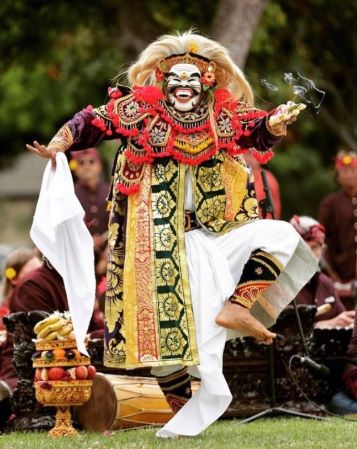
Originally published in the Marina Times San Francisco in April 2023
In Beyond Bollywood: 2000 Years of Dance In Art, the Asian Art Museum reveals the power of dance in South and Southeast Asia from modern movie classics to the temples of ancient times. Featuring more than one hundred and twenty artworks borrowed from twenty-five museums, this multimedia exhibit immerses museumgoers in dance via contemporary sculpture, painting, textiles, jewelry, photographs and more. Visitors will gain a deeper understanding of the enduring power of dance to inspire art and audiences alike.
Gods and Glamour
“The world loves Bollywood films for their famously elaborate choreography, and we wanted our community to be able to appreciate the deep historical, spiritual-and even economic and political – roots of dance across South and Southeast Asia, as well as parts of the Himalayas,” says Jay Xu, the Barbara Bass Bakar Director and CEO of the Asian Arts Museum. The gallery includes experiential theatrics from musical backdrops to large video installations. Throughout its duration, Beyond Bollywood will include scheduled live performances in the main pavilion itself, as well as numerous dance performances and programs. Movement and rhythm, whether sacred or secular, is rooted in ancient ritual and tradition. The form contains a function of life force, “…birth and death, global creation and destruction, gangs of gods and goddesses setting the pulse of the universe,” says director Xu.
Thematic Galleries
Beyond Bollywood is divided into five thematic sections: Destruction and Creation; Devotion; Subjugation; Glorification; and Celebration. Each thematic gallery sets a tone with a single historic artwork combined with music and immersive video to create an environment of experience for each subject.
The first gallery, Destruction and Creation (awe), begins with a Chola-dynasty bronze Shiva Nataraja, the Lord of Dance demonstrating the “dance of bliss”. Shiva is one of the principal deities of Hinduism and represents creation and destruction, a power which transforms the universe. Next, the Devotion (longing) gallery opens with another major Hindu deity, Krishna. In Krishna Dances with The Cowherd Women from 1850-1900, the god of protection, compassion, tenderness and love joins a circle of cowherd women in the “dance of divine love.” In Subjugation (fear and release), domination and control is exemplified by a bronze work from 1050-1100, Dancing Hevajra surrounded by dancing yoginis. A multi-limbed protective Buddhist deity, Hevajra is shown dancing on a demonic corpse, a symbol of overcoming illusion or maya. The dancing yoginis are powerful female deities circling Hevajra on the cremation ground. A masterpiece of Angkor stonework from 1075-1125 C.E. marks the beginning of Glorification (reverence). Dancers and musicians entertaining a deity or nobleman depicts a complex of female dancers performing before a princely male figure. Likely based on a story from mythology, the nobleman sits calmly at the center of the stone frieze under a parasol and is cooled by a servant fanning him. Celebration (joyful exuberance) is represented by Dancing villagers, a painting attributed to Pandit Seu dating from 1730 C.E. The dancers, in their varied poses as they interact with the unheard, imagined music performed by musicians on the far right of the image epitomize the vibrant power of dance in front of a bright orange background.
In Beyond Bollywood, dance is a moment captured. Dance is ritual, entertainment, and a way to interact with the gods who create the world we inhabit. Forrest McGill, Wattis Senior Curator of South and Southeast Asia at the Asian Art Museum says, “The goal is for audiences – whether already familiar with these dance traditions or encountering them for the first time – to come away with a fresh appreciation for the skill of both the artist memorializing a dance and the dancers themselves, as well as the raw emotion and pure devotion that ignites them.”
Public Programs Feature Crafts and Bay Area Dance
Daily exhibition-related artmaking will take place in the Shriram Experiential Learning Center. Dance schools and performers in the Bay Area will supplement this exhibit with live performance. Dance Dialogue is a performance pop-up occurring on the Second Sundays and Thursdays in the exhibition galleries. The Beyond Bollywood Dance Series will take place monthly, and Family Fun Days will be on the first Sunday of the month and include dance-themed activities for all ages.
Sharon Anderson is an artist and writer in southern California. She can be reached at mindtheimage.com